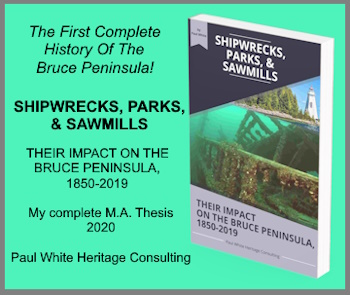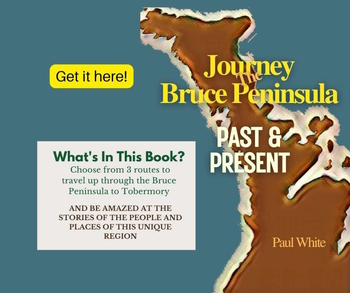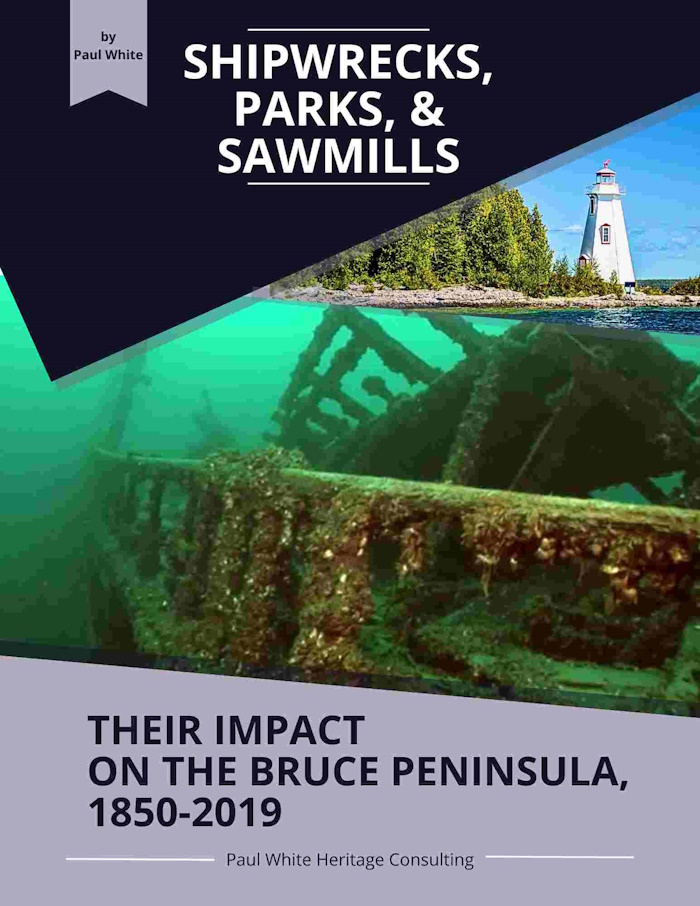Bruce Peninsula Winters Could be Difficult
Bruce Peninsula winters could be difficult, especially in pioneer times when good transportation connections were limited to only a few months each year.
As the holiday season approaches and the winter freeze-up of the harbour comes nearer, concern about travel and the shipment of goods causes little worry today.
However, in the early days of settlement in this area, the onset of winter meant the beginning of isolation from the rest of world.
In the December 5, 1879, edition of the Wiarton Echo, the newspaper’s Manitowaning correspondent put an ironic slant to the impending isolation forced on that community by the coming of winter.
“Navigation is almost closed, and for about six months our only communications with the outside world will be by dog train. Some people might be inclined to pity the lot of us poor islanders, but we can assure them there is no need for it, as a gentleman put it last winter, 'if that insignificant portion of the universe known as the outside world can get along without us, why we can surely get along without them.”
For communities such as Wiarton and Tobermory, where the coming of the railroad was a distant reality, and the few roads that existed were often impassable for much of the winter months and the communities and on Manitoulin Island where the winter freeze-up of the Great Lakes meant no water traffic – winter represented isolation and self-dependency. Food supplies were available in limited quantities from the local merchants.
Therefore, the months leading up to the Bruce Peninsula winter were spent harvesting and storing what the family had grown on their own land, or buying, or trading food staples from neighbours.
The Echo reported in each issue the almost frantic comings and goings of vessels from the local harbour.
In the Dec. 5, 1879 edition, the Echo noted that the Wiarton Belle "left here on her last trip to Owen Sound yesterday morning.”
In the same edition it was announced that the "Presqu'isle light will be shut down for the season Friday night ... Griffith's Island and Owen Sound lights closed today."
In the December 12, 1899 edition of the Echo, the editor praised the efforts of the Prince Alfred for continuing to try to maintain a service between Owen Sound and Wiarton.
The editor suggested that the citizens of Wiarton were grateful for the bravery of these attempts.
The uncertain Bruce Peninsula winter weather conditions at this time of year, and the frenzied pace to get passengers and goods, from one harbour to another, led to the increased possibility of shipping disasters.
Throughout the history of Georgian Bay maritime travel there were many ships that experienced close calls, groundings, and sinkings at this time of year.
In fact, the infamous sinking of the Waubuno and many other legendary disasters occurred in the months of November and December when the race against the elements was at its most furious pace.
Not all the close calls were disastrous. In fact, a trip made by the Jane Miller in November 1879 illustrates how Grey-Bruce travellers coped with the hardships imposed on water transportation by the Bruce Peninsula winter weather.
Almost an hour after leaving Owen Sound on her way up the peninsula to Manitoulin, the Jane Miller encountered a violent storm.
Rather than returning to Owen Sound, she continued on her course, often seeking refuge in harbours when conditions became too dangerous.
It was reported that in one harbour the passengers landed and picked beech nuts, and at another location they gathered cordwood.
For five days the Jane Miller's fate was unknown by those awaiting her arrival.
When she finally arrived at her destination, the Echo reported, “the arrival of the first boat of the season or the departure of the last could not have created greater excitement.”
So incredible was the saga of the Jane Miller, the editor of the Echo suggested that "the Jane had better be given a contract for carrying mail matter."
The dangers involved in maritime travel and the urgency of the onset of Bruce Peninsula winter, brought the inhabitants of these isolated communities closer together which may have served to sustain them throughout the months of winter isolation.
I would like to suggest to our neighbours on the Bruce that when you jump into your car and drive into Owen Sound or other more southerly points to go Christmas shopping or just to buy groceries consider the conditions that pioneers of your area faced during the holiday season not so long ago.
A version of this article, "Bruce Peninsula Winters Could be Difficult," originally appeared in my Local History column in the Owen Sound Sun Times, in December, 1994.
Discover More About the Bruce Peninsula
Getting to the Bruce Peninsula is a relatively easy driving trip. Here are driving directions from three regions to the peninsula.
Bruce Peninsula Lumber History details the impact of the forest products industry on the development of the region.
Bruce Peninsula Lumbering provided the stimulus to develop and grow the pioneer economy on the newly settled Bruce Peninsula.
Bruce Peninsula Municipal Politics: No matter what the venue, or the issue, seldom is a popular decision made that suits everyone.
Bruce Peninsula Travel Routes were often a matter of debate because in the early years, land travel was virtually unattainable for settlers and lumbermen alike.
Bruce Peninsula winters could be difficult, especially in pioneer times when transportation connections were limited to only a few months each year.
Colpoys Bay Vista - Awesome! A short drive from either Wiarton or Owen Sound is one of the most magnificent views to be found in the province of Ontario!
Forest Products on the Bruce Peninsula contributed greatly to the growth and development of that region of the province of Ontario.
Gillies Lake: aka Ghost Lake has a mysterious past as its original name, Ghost Lake, implies.
Great Grey Owls on the Bruce Peninsula was a surprise discovery for ornithologists and others. Sadly, the story of their visit had an unfortunate conclusion.
Pioneer Campers: Hope Bay mostly considered the peninsula untamed wilderness and some of the locals were not about to disappoint them!
Pioneer Missionary James Atkey arrived on Colpoys Bay to minister to the native community near Oxenden until a treaty uprooted his parishioners.
Pioneer tourists first visited the Bruce Peninsula in the 1800s and the region continues as a great recreational and tourism destination today!
Pioneer Vacations on the Bruce Peninsula got an eerie start in the Hope Bay region of the peninsula.
Lighthouses Lighthouses were vital to Georgian Bay Sailing.
A Flowerpot Island cruise is not only entertaining, but it is also very educational as you will see things that you have never viewed before!
Travel the Bruce: Owen Sound to Wiarton A wonderful journey from Owen Sound to Wiarton.
Travel the Bruce: Wiarton to Tobermory Relaxing and historic journey.
Bruce Peninsula The Bruce Peninsula is a compelling place, with a rich history, to visit. Once you have traveled there, we guarantee that you will return, again and again!





